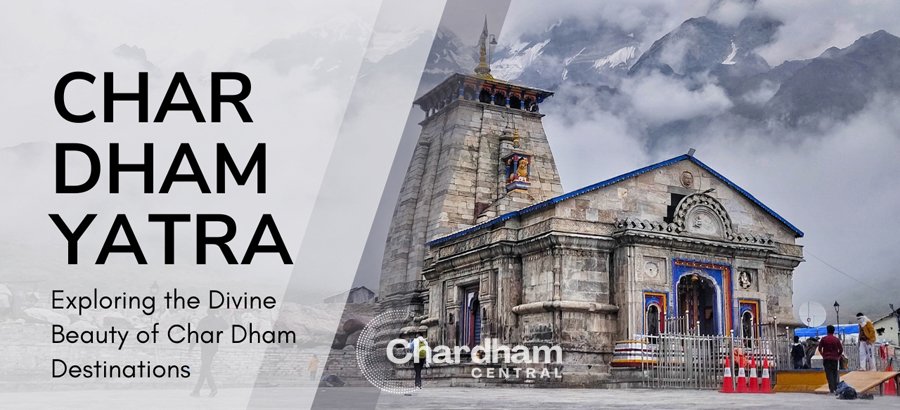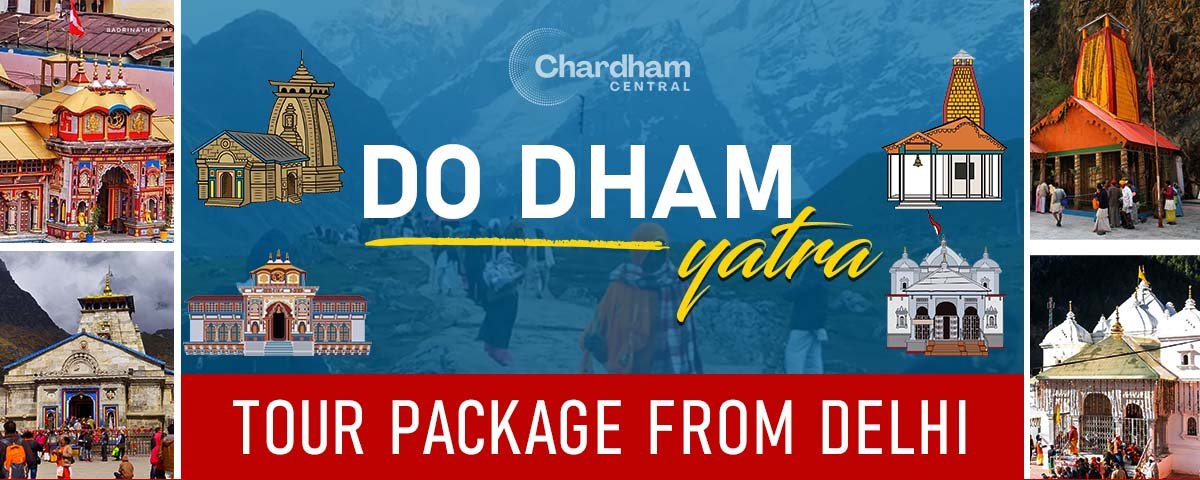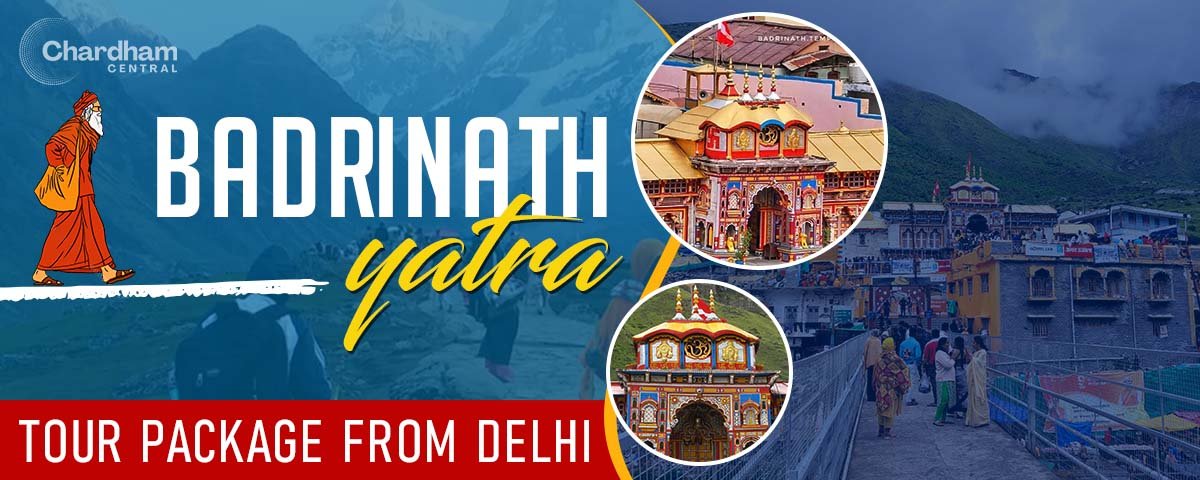
Badrinath Temple
Badrinath Temple also known as Badrinarayan Temple or Badri Vishal is one of Hinduism’s most revered pilgrimage destinations dedicated to Lord Vishnu. Located in the scenic town of Badrinath in Chamoli district, Uttarakhand, this sacred Lord Vishnu temple in Uttarakhand sits at an altitude of 3,133 meters (10,279 feet) amidst the serene Garhwal Himalayas.
Rich in spiritual and historical value, the Badrinath Mandir history dates back centuries and plays a central role in the Char Dham Yatra, drawing lakhs of devotees every year. Badrinath temple is located beside the holy Alaknanda River and surrounded by the beautiful Garhwal hills. In front of the temple stands the tall Nar Parbat mountain, while Narayana Parbat and the famous Neelkanth peak rise behind it. Together, these mountains create a peaceful and spiritual atmosphere for pilgrims.
Badrinath Temple History
Badrinath Temple is a popular destination for pilgrims for hundreds of years and is a major place of worship for followers of Lord Vishnu. The Badrinath Temple history goes back many centuries and holds great importance for devotees of Lord Vishnu. It is believed that Lord Vishnu meditated here in the form of Nar-Narayan, making the place very sacred.
In the 8th century, the famous saint and philosopher Adi Shankaracharya visited this area and re-established the temple, helping to revive Hindu traditions. This is why Adi Shankaracharya is an important part of the temple’s story. Over time, the temple has been repaired and rebuilt many times due to the harsh weather in the Himalayas, but its spiritual value has remained strong.
Mythology Legends Associated with Badrinath Temple
The Badrinath Temple story is filled with interesting myths from Hindu religion. It is believed that Lord Vishnu once came to Badrinath and sat in deep meditation. To protect him from cold weather, Goddess Lakshmi turned herself into a Badri tree and gave him shelter. Because of this, the place became known as Badrinath Dham. It is also said that Narad Muni, a great sage, meditated here and Lord Vishnu blessed him. Near the temple is Tapt Kund, a natural hot spring, which is believed to have healing powers. These stories show the Badrinath Temple’s mythological significance and make it a very special and holy place for devotees.
Significance of Badrinath Temple
Badrinath Temple is one of the most sacred Hindu temples and an important part of the Char Dham Yatra in India, as well as the Chota Char Dham circuit in Uttarakhand. It holds deep spiritual value for devotees of Lord Vishnu. The temple is also one of the five temples in the Panch Badri pilgrimage and is counted among the 108 Divyadesams—holy shrines dedicated to Vishnu. A special feature of Badrinath is the Tapt Kund, a natural hot water spring where pilgrims bathe before darshan. The water is believed to have healing and spiritual benefits, which adds to the temple’s religious importance.
Architecture and Design of Badrinath Temple
The current Badrinath Temple structure was revived in the 8th century CE by the great saint Adi Shankaracharya. He found the idol of Lord Badrinarayan in the Alaknanda River and first placed it near the Tapt Kund hot spring. Later, a proper temple was built at the present site and has been restored by several rulers, especially the Garhwal kings.
Badrinath Temple is a famous Vishnu temple in Uttarakhand, standing about 50 feet tall and built in the traditional North Indian Nagara style combined with local Garhwali architectural elements. Made of large stone slabs, the temple features a cone-shaped, multi-layered roof with a tall shikhara (tower) above the sanctum. It has three main sections: the Garbha Griha (sanctum) housing the black stone idol of Lord Badrinarayan; the Darshan Mandap for prayers and rituals; and the Sabha Mandap where devotees gather.
The colorful facade of the Badrinath architecture is painted red and yellow, with beautifully carved windows and arched doorways. The golden roof adds charm and shows some Tibetan influence. Just outside is the sacred Tapt Kund, a natural hot spring where pilgrims bathe before entering the temple.
Deity and Rituals at Badrinath Temple
The main deity of Badrinath Temple is Lord Badri Narayan, a black stone idol representing Lord Vishnu in a peaceful form. It is placed in the Garbha Griha and is surrounded by idols of Nar and Narayan, Uddhav, Garuda, and Kuber. Every day, special prayers and rituals are performed, including Mahabhishek, Alankara, and Vishnu Sahasranama chanting in the morning. In the evening, Aarti and Shayan Aarti are held before closing the temple.
During the summer months, the temple is open to devotees with a full schedule of pujas and darshans. In winter, when the temple closes due to heavy snowfall, the idol of Lord Badri Narayan is ceremonially moved to Narsing Temple in Joshimath, where rituals continue.
Seasonal Opening & Closing of Badrinath Temple
Badrinath Temple opens every year on the auspicious day of Akshaya Tritiya, which usually falls in April or May. The exact Badrinath Temple opening date 2025 is announced by temple priests. The temple remains open for six months and closes on Bhai Dooj, a festival that comes after Diwali, usually in October or November. The kapat opening and closing of the temple are marked by grand religious ceremonies attended by priests, devotees, and local officials. During the winter months, due to heavy snowfall, the temple becomes inaccessible. As part of the tradition, the idol of Lord Badrinarayan is ceremoniously shifted to Pandukeshwar near Joshimath, where devotees can continue worship until the temple reopens in the spring.
Location and Access to Badrinath Temple
Badrinath Temple is located in the center of Badrinath town in Uttarakhand, right along the banks of the Alaknanda River. For those looking for how to reach Badrinath Temple, it is important to know that vehicles are allowed up to the main entrance gate. From there, a well-paved walking path of about 100 meters leads to the temple sanctum. The route includes a few steps and a slight incline, but is manageable for most visitors. This Badrinath temple entry information helps ensure a smooth visit for all pilgrims.
Dress Code and Temple Etiquette at Badrinath Temple
Badrinath Temple is a sacred destination, and devotees are expected to maintain respectful behavior and attire while visiting. Although there is no strict official dress code at Badrinath Temple, it is advised to wear modest and traditional clothing. Women usually wear sarees or salwar-kameez, while men opt for dhoti-kurta or trousers with shirts. Wearing shorts, sleeveless tops, or revealing outfits should be avoided out of respect for the spiritual atmosphere of the shrine.
Among the rules inside Badrinath Temple, the use of mobile phones and cameras is strictly prohibited within the temple premises. Photography is not allowed inside the sanctum. Pilgrims visiting for the first time should maintain silence inside the temple, avoid pushing during darshan, and follow the instructions given by the temple staff or priests.
Important Facts About Badrinath Temple
Whether you’re planning a visit or just curious, these Badrinath Temple facts will help you understand the temple’s significance, traditions, and visitor guidelines.
- Badrinath is the only Char Dham temple located in North India; others are in the South, East, and West.
- Badrinath Temple is part of the Char Dham sites in Uttarakhand and holds great religious significance in Hinduism.
- Badrinath temple remains closed during the winter months due to heavy snowfall and reopens annually on Akshaya Tritiya.
- Photography is strictly prohibited inside the Badrinath Temple, especially within the sanctum sanctorum. The use of mobile phones and cameras is restricted within the inner premises to maintain decorum and spiritual sanctity.
Badrinath Temple FAQ's
Badrinath Temple is managed by the Shri Kedarnath Kedarnath Temple Committee under the Uttarakhand government.
Badrinath temple welcomes devotees from all castes and faiths without any restrictions, but visitors are expected to respect the customs and rituals there.
Online donations and puja bookings are available at Badrinath Temple through the official temple website for devotees worldwide.
Pilgrims visiting Badrinath Temple are allowed to take photos outside the temple premises. However, photography inside the temple, especially within the sanctum, is strictly prohibited. Visitors are advised to respect the temple rules and maintain the sanctity of this sacred site.





